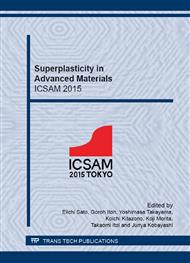p.183
p.190
p.196
p.202
p.208
p.214
p.220
p.225
p.231
Chronicling the Development of a High Strength 5xxx-Based Superplastic Aluminium Alloy
Abstract:
In recent years there has been a largely unspoken demand for a high strength, non-heat treatable aluminium alloy for superplastic forming applications. This is particularly true for the automotive industry since the high strength, superplastic aluminium alloys, such as AA7475, are both too time consuming (in forming and heat treatment) and too expensive. Compound this with the expense of corrosion protection and almost all aluminium alloys except for AA5083 fall by the wayside for the automobile industry.However, the need for a higher strength alloy has remained. To achieve this Hydro has systematically investigated the basis behind the superplastic forming of AA5083. On this basis a new high strength 5xxx alloy was extrapolated. The resulting alloy was then characterised and benchmarked against the existing SPF alloy, AA5083. The new alloy, an AA5456-type alloy demonstrated a higher strength than AA5083 while improving the formability and rate of forming. This paper will discuss some of the lessons learned during the development of this alloy.
Info:
Periodical:
Pages:
208-213
Citation:
Online since:
January 2016
Authors:
Keywords:
Price:
Сopyright:
© 2016 Trans Tech Publications Ltd. All Rights Reserved
Share:
Citation:


